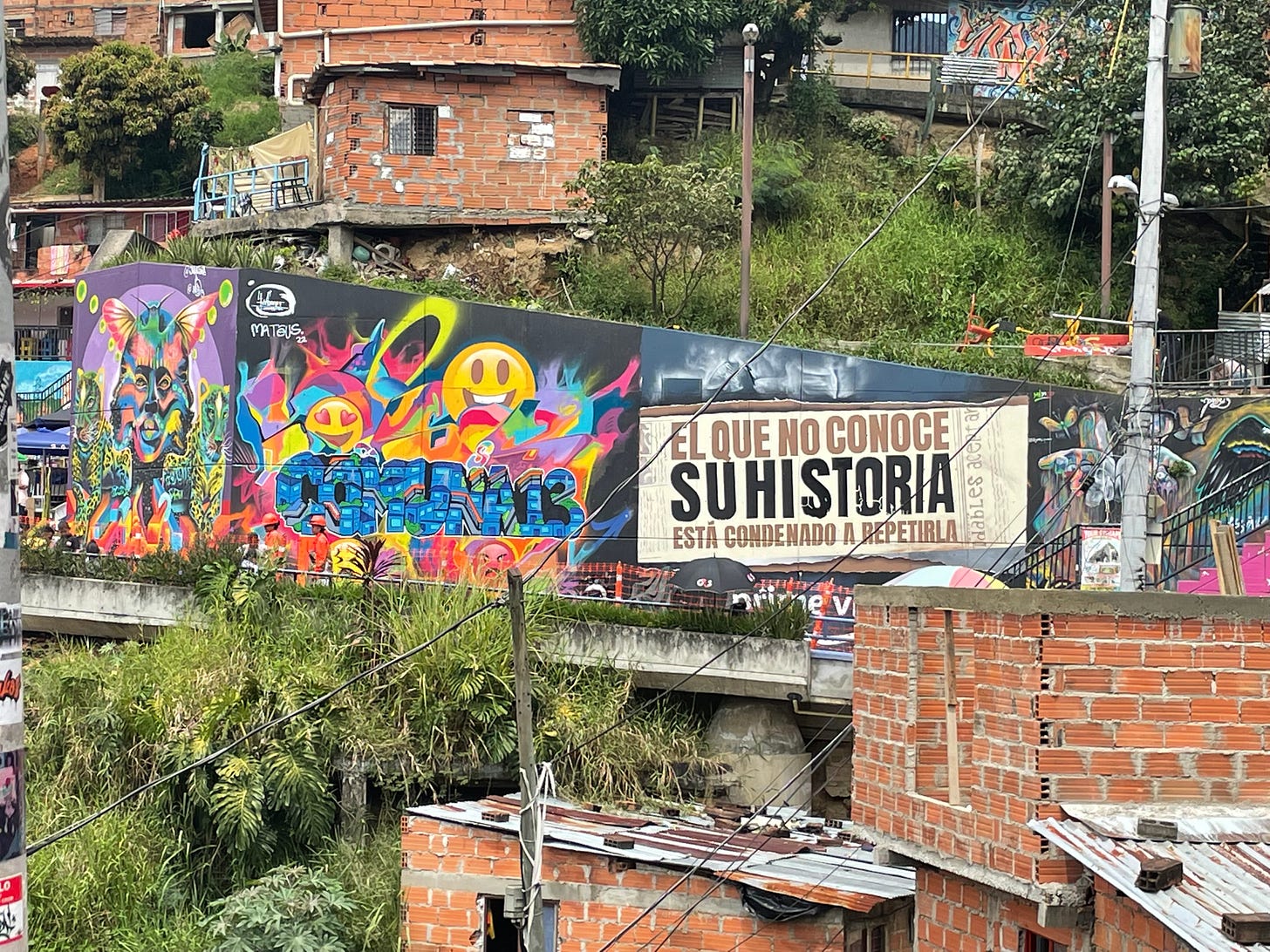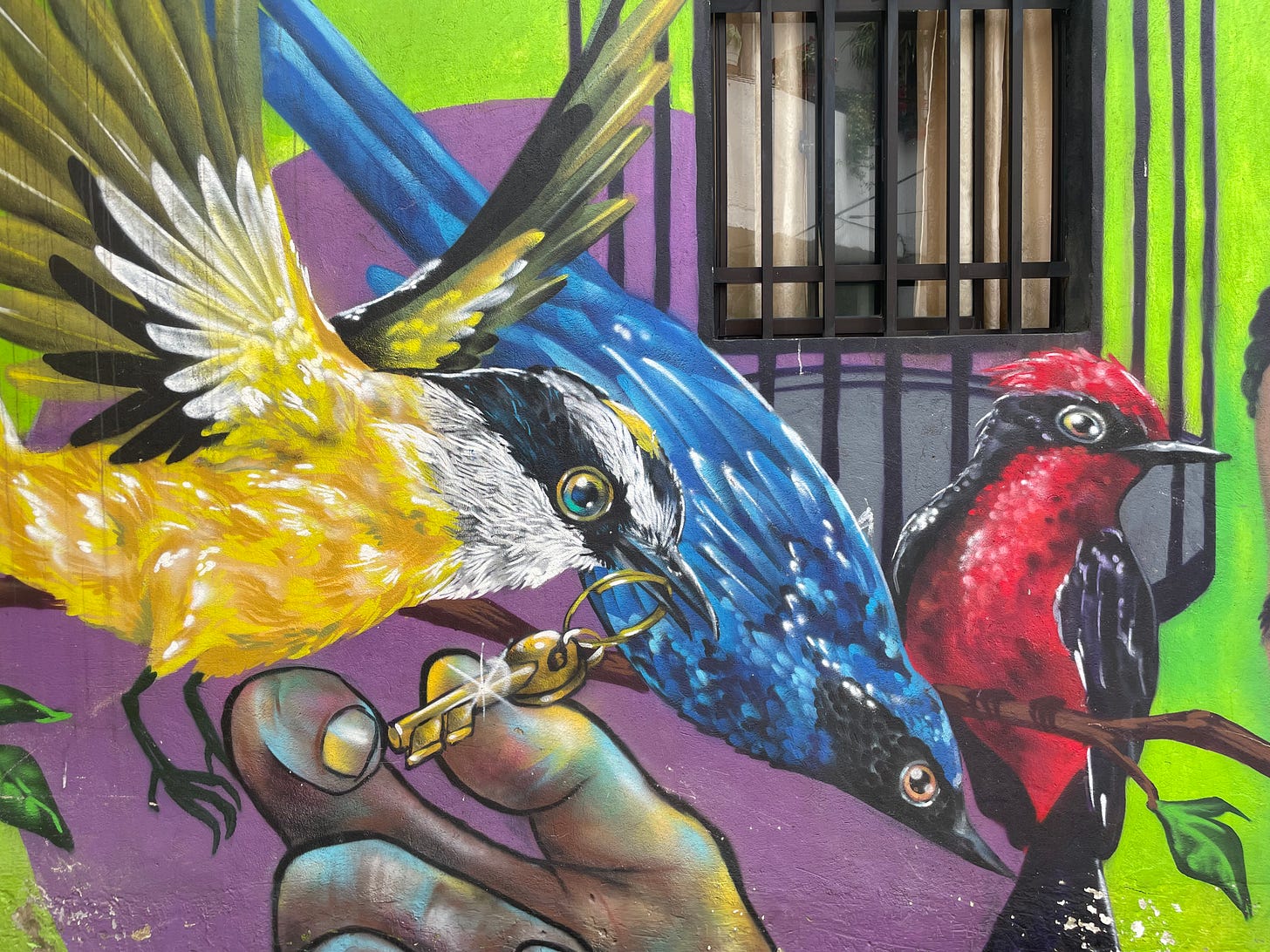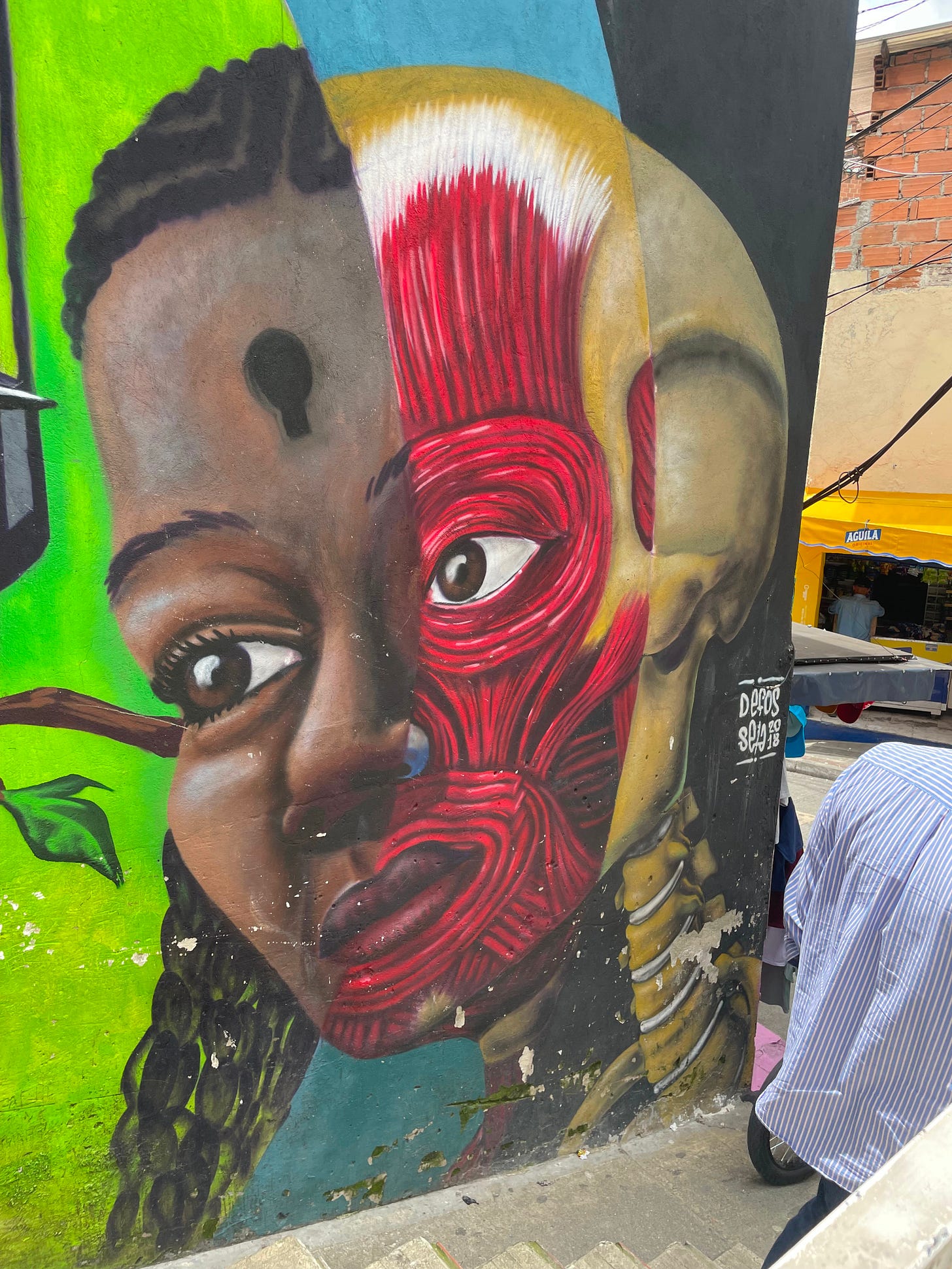Jubilee 2025: Create
The Jubilee of Artists is February 16 to 18, 2025.
Nestled in the Aburrá Valley, in the Andes Mountains of Colombia, lies the bustling metropolis of Medellin. It is the second largest city of the country, and its pleasant climate has earned it the moniker “City of the Eternal Spring.” The city is full of activity and hosts the world-famous Feria de las Flores, or Flower Festival, every year. This ten-day fiesta showcases the incredible bio and cultural diversity of Colombia and is attended by 30,000 tourists from South America and beyond. Of particular importance to the Feria de las Flores are the handmade silleteros, which are designs made entirely from flowers and flower petals that are carried on the backs of volunteers in parades on the last day of the festival. Silleteros have a fascinating history and are on display throughout the city. Some are just decorative, others are religious or educational themed, and still others are sponsored by companies, like the one below.
But there’s another area of Medellin that also attracts many tourists. Like the Feria de las Flores, this tourist attraction is also a nod to Medellin’s past, but to a much darker and more violent past. The area is simply called Colona Trece, and it was transformed from the epicenter of violence between drug cartels during the 1980’s and 90’s to a safe, welcoming and vibrant community today. What makes its transformation so remarkable? It was largely done by artists.
Located high up on the mountainside overlooking Medellin, Colona Trece was the perfect spot for the nest of criminals and drug dealers who ruled over it viciously. Not only was it one of the poorest districts in the town, so it was unlikely that its citizens could mount much of an offensive, but it’s location also meant that it was cut off from all the advantages of the town below. For a long time, the only way in or out of the area was on foot, straight up steep paths, roughly the equivalent of 28 stories. As a result, there was zero police presence and no city utilities or funding.
But even before the drug wars of the cartels moved in, this area was already connected to the 10-year civil war that raged in Colombia between guerillas and paramilitary groups. Fleeing the violence that took place in the mostly rural areas, people arrived in Medellin with nothing and nowhere to go and started building over again by forming informal settlements in the hills. It didn’t take long, unfortunately, before those same groups the people had fled realized that these makeshift communities were the perfect place to gather new recruits, establish control and set up black-market systems.
Suffice it to say, the violence and despair that was synonymous with the name Colona Trece lasted for decades. It was one of the most dangerous places in the entire world. Even today, if you go to visit the district, your tour guide will simply point across the tiled rooftops below, out to the open hills beyond the city and say something like, “We do not build over there because we all know that’s where the mass graves are, and we will not forget them.”
It’s a sobering, horrific sight of the reality of what people will do to other people.

Standing in Colona Trece, as I did a couple of years ago, one wonders what on earth could be powerful enough to overcome such misery and suffering, so many decades of violence? What could possibly change the spirit of despair to one of healing, even hope?
But change did come and from different two places - a visionary city planning idea and artists from within the community itself. The first idea was radical yet fairly simple, to install a cable car system, very similar to the ones used at ski resorts, up the mountain so that the district would be connected to the city below and people could leave every morning for better opportunities outside Colona Trece. Assisting the poor was tied to a simple means of transportation that was safe and reliable, overcoming the isolation imposed by the terrain and socioeconomic conditions. The first of the six lines planned of the Metrocable opened in 2004 and transported 5,234,4581 passengers in its first year. The final of the six lines was just completed and opened in 2021.
Building on the success of the cable cars, massive outdoor escalators have also since been built, transforming a difficult half hour climb into a six-minute journey.
In the early 2000s, while the city was planning the civil engineering projects2, the residents of Colona Trece had also begun to push back, but in an unusual manner. Musicians, dancers and street artists began painting the walls and holding dance performances and impromptu concerts, speaking out against the violence and marginalization and advocating for peace and harmony. Young people were encouraged to express themselves through art, instead of joining gangs. The artists used what they had, so concrete walls became murals and open spaces were used for breakdancing demonstrations and rap battles.
Overtime, more and more children became trained artists, dancers and singers. Wanting to not only support themselves but also showcase their talents, the artists began organizing walking tours that told the history of Colona Trece and how it was changed through art AND engineering. Today, residents of the Colona are able to sell refreshments, handicrafts, clothes and, of course, art, out of the windows of their homes to the tourists. They tell the tale of the courageous stand a few people took, in turning away from guns and drugs and embracing creativity and imagination as a way to transform lives.

And what a courageous stand that must have been! It seems utterly absurd to believe that singing a few songs and painting some walls could ever make any difference, that these things had the power to chase out the terror that had dominated for decades. But Colona Trece is the proof of the transformative power that artists and their works really have.

Different forms of art, from the beautifully designed cable cars and orange-roofed outdoor escalators, to the murals, dancing and street art, remind us of the human need to create. We are all creators, because the One who made us loves to create, and we are called to create in his image. While not everyone is asked to make what we typically think of as “art,” Pope St. John Paul II tells us that “all men and women are entrusted with the task of crafting their own life: in a certain sense, they are to make of it a work of art, a masterpiece.”3 It is vitally important, then, that every person thinks of themselves as a creator, as one who participates in creating, because that’s one of the fundamental truths of our existence. Colona Trece is an obvious example of collaboration between different types of creators.
In order to overcome the immense and deep-seated evil in that area, all kinds of creators were required. Those who can create songs and dances and paintings were necessary to give voice to the suffering of the people, as well as to make their prayers visual and shared. By taking up words, sounds, paint, stone, marble and glass, artists in general create “works of beauty capable of lifting the soul to God.”4 But those who elevate folk art, like those in Colona Trece, take on a special role. Pope St. John Paull II wrote that, “Folk artists take up local materials and inherited artistic traditions to enculturate their faith. In giving aesthetic forms to ideas conceived in the mind and feelings evoked in the depths of the heart, artists and craftsmen engage in a spirituality of artistic service which contributes in its way to the life and renewal of a people.” 5 Folk artists play a particularly important role in the economy of artistic service because they translate the needs and prayers of their own people, mixed with their own culture and geography, and elevate them into something new. They incarnate the hopes, prayers and dreams of a particular people at a particular time, while also expressing these needs in a universal yet unique manner.
As valuable and necessary as folk artists are in being the voice of a people, they cannot succeed alone. The creative talents of engineers, architects, financiers and even administrators were also required to take the Metrocable from an idea to a reality and turn Colona Trece into a place of welcome and hospitality.
The creative abilities of every person are required to overcome evil. We don’t typically think that way, believing that creativity is for “artsy” people, but we are creating all the time, in small or bigger ways. For example, cleaning a house is also creating an inviting, welcoming place for those who live there. Making a meal is creating something new, something to be enjoyed and shared, even if we don’t necessarily consider ourselves chefs. Even the words we speak are creative, as they can form spaces of warmth, understanding and generativity or hostility, suspicion and division. We create because we are made in the image of our Creator, but that same Creator gave us free will to decide what we will create. Accordingly, we can make a place that witnesses to the Kingdom of God, or a hell that witnesses to its opposite. Colona Trece has lived both.
The importance of creativity is why there is a Jubilee of Artists during this Jubilee Year. From February 16 to 18, artists of every kind are invited to “journey on the ‘way of beauty,’ the via pulchritudinis, to encounter Jesus Christ, “the image of the invisible God.” (Col 1:15)” and to use our creativity to make Him visible, to incarnate Him.
In his 2023 Address to Artists, Pope Francis thanked artists of all types for helping “us to make room for the Spirit. When we see the work of the Spirit, which creates harmony from differences without destroying or standardizing them but bringing them into harmony, we come to understand what beauty really is. Beauty is that work of the Spirit which creates harmony.” The harmony that Pope Francis is talking about is much more than an aesthetically pleasing painting or a well written story. It’s the harmony that reconciles and restores, that brings together disparities in new, fresh and revitalizing ways, championing the “defense of human life, social justice, concern for the poor, care for our common home”6 and ultimately, “universal human fraternity.”
Let’s pray with Pope St. John Paul II for discernment of the use of our creative faculties, so that we will “help to affirm that true beauty, which as a glimmer of the Spirit of God, will transfigure matter, and open the human soul to the sense of the eternal.”7
If you would like to leave me a tip and support my work, you can that through my Paypal link below:
Tip Jar for The Strawberry Vine
Government of Antioquia. "Statistical Yearbook of Antioquia 2014". www.antioquia.gov.co.
The government was also responsible for a violent 4-day crackdown on Colona Trece called Operation Orion. Different Colombians say various things about this military operation, but certainly many civilians were also injured and killed. Although this event did get rid of some of the groups, it left others behind and did not succeed in bringing peace. Overall, Operation Orion was proof that violence is only likely to bring still more violence.
Pope St. John Paul II, Letter to Artists, no.2
“Pilgrims on the Way of Beauty: A Resource for the Jubilee of Artists” USCCB.org
Letter to Artists, no. 4
Pope Francis, 2023 Address to Artists
Letter to Artists, no. 16











